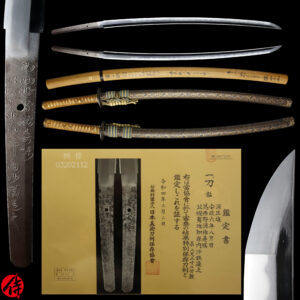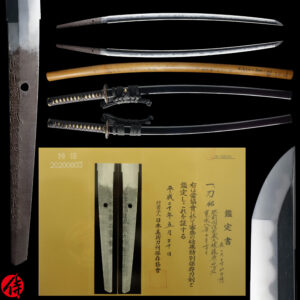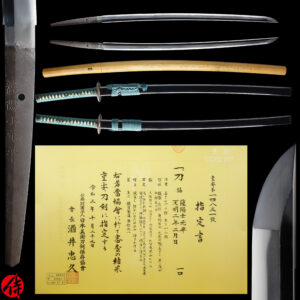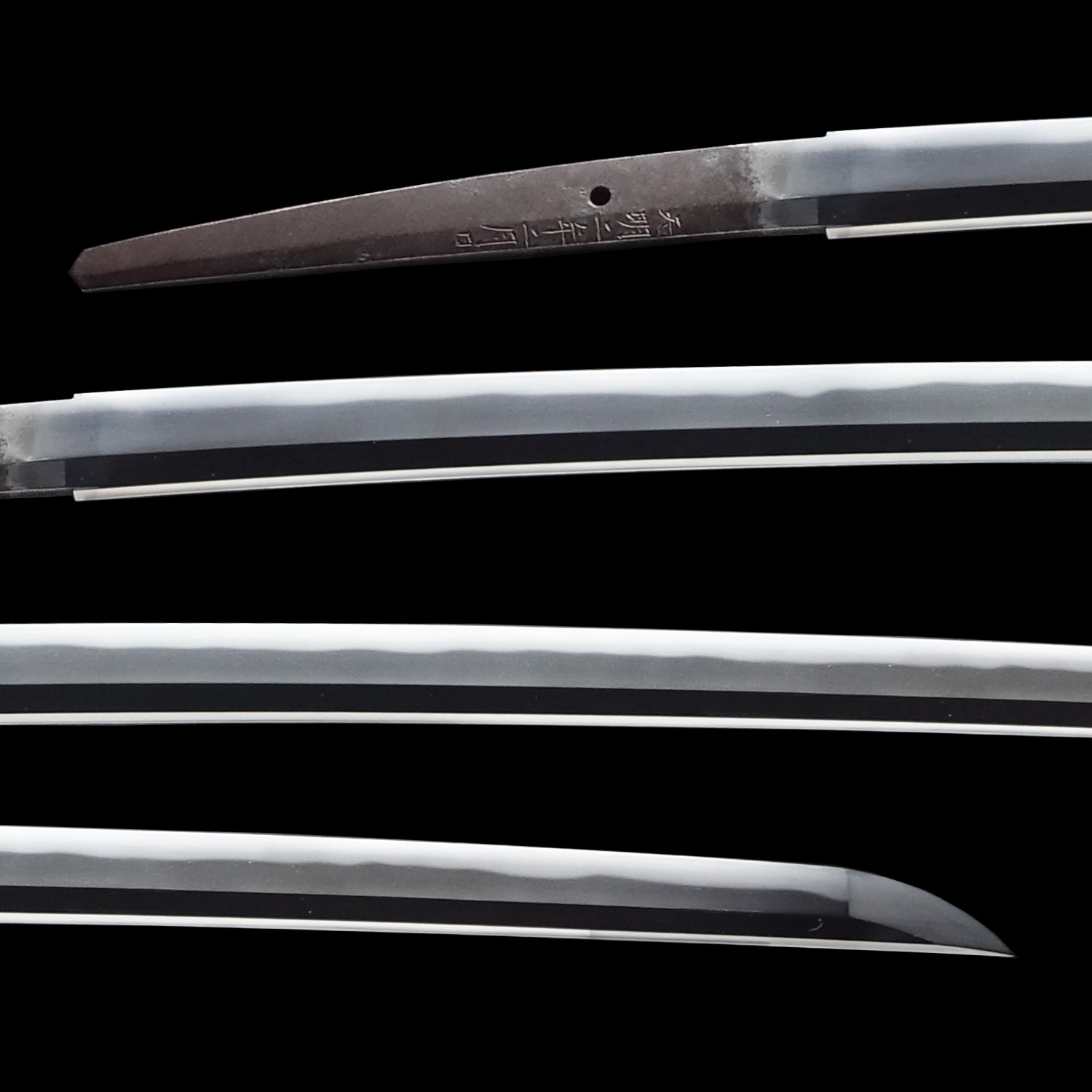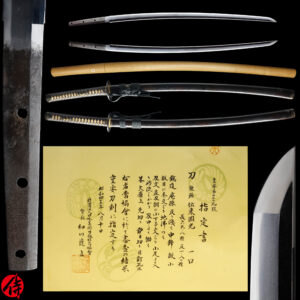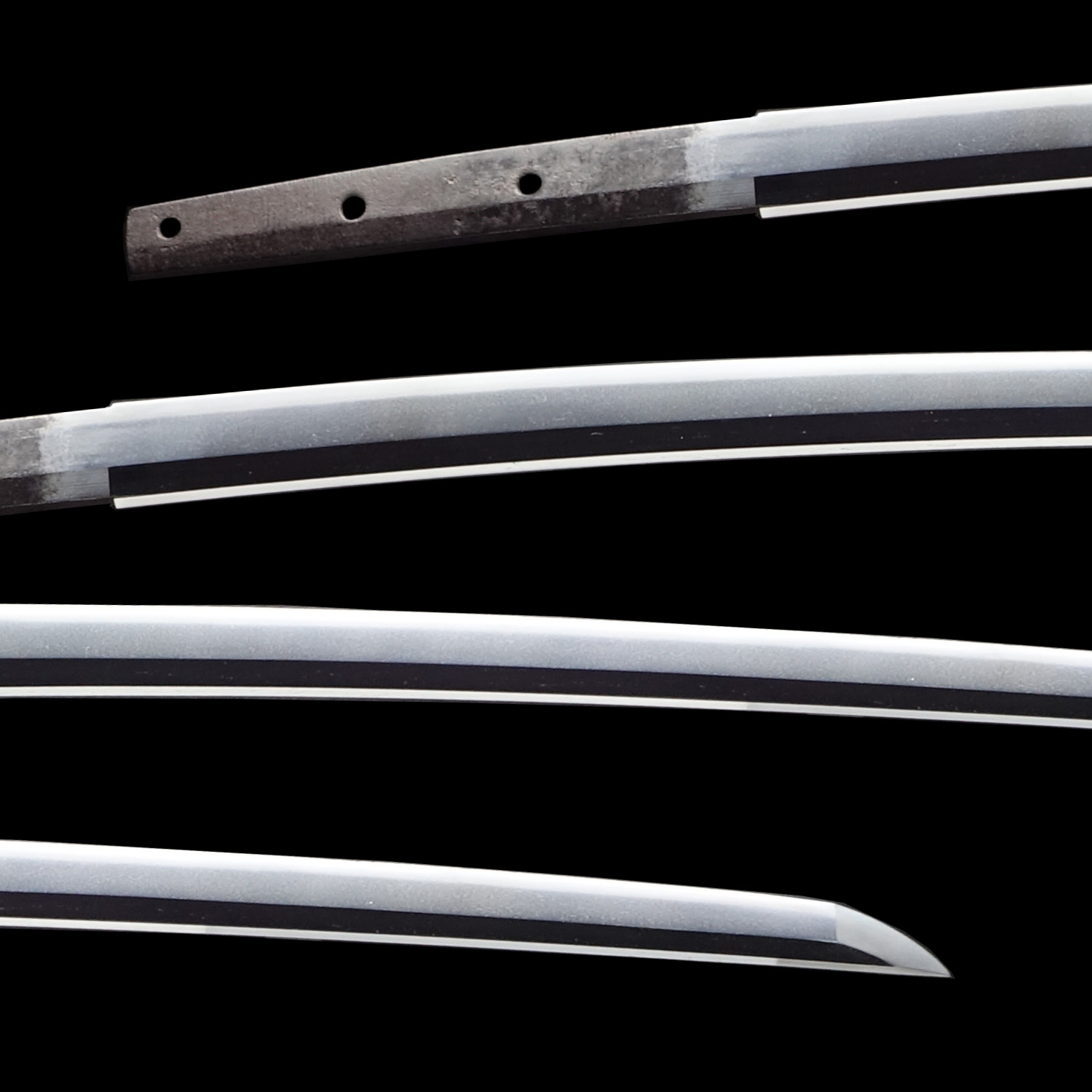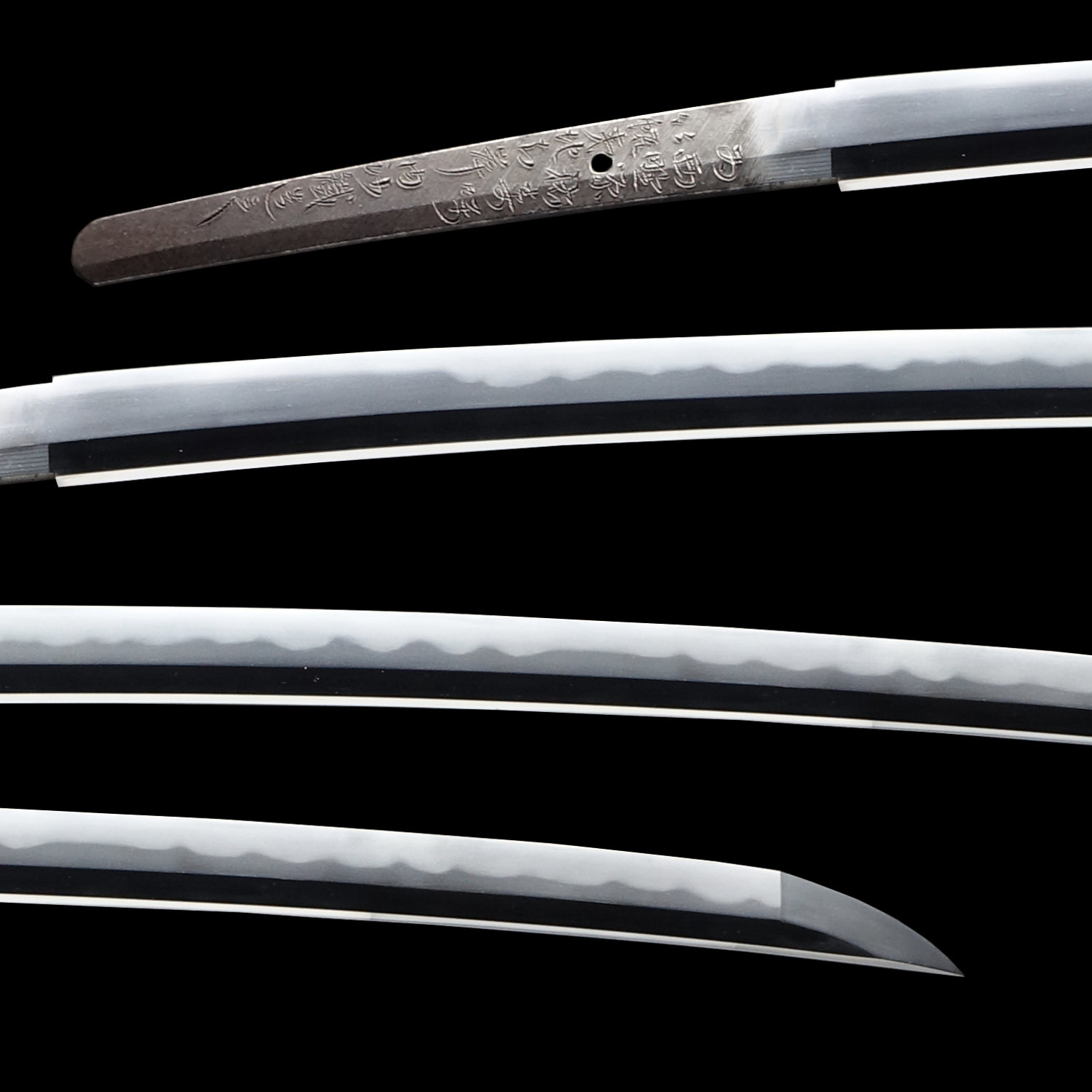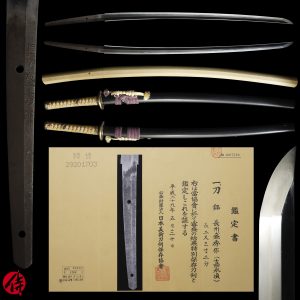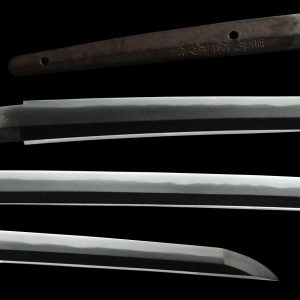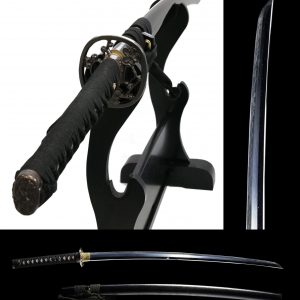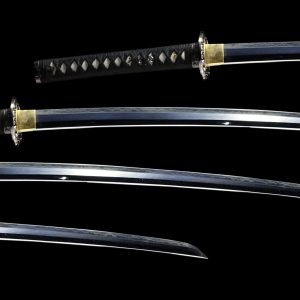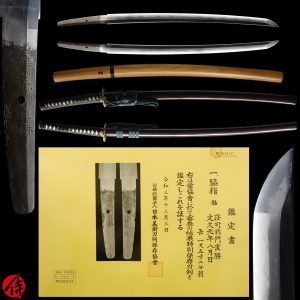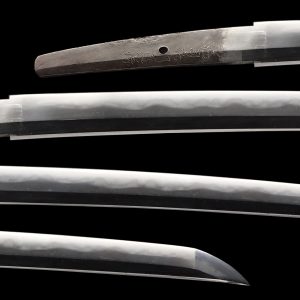Antique Japanese Sword Daisho Signed by the third-gen/fourth-gen Kyo Yoshimichi with NBTHK Tokubetsu Hozon Certificate
【Description】
Summary
The Katana blade was signed by the third-gen Kyo Tanba no Kami Yoshimichi (三代京丹波守吉道), who was active during 1661-1681. And the Wakizashi blade was signed by the fourth gen Kyo Tanba no Kami Yoshimichi (四代京丹波守吉道), who was active during 1673-1688. The swordsmith name Yoshimichi prospered in both Osaka and Kyoto for generations during the Edo period. And to distinguish two Yoshimichi, The one in Kyoto is called Kyo Yoshimichi, and the other one is called Osaka Yoshimichi. NBTHK judged which generation of Kyo Yoshimichi forged each blade and mentioned in the certificates. Both the third-gen and fourth gen Kyo Yoshimichi belonged to the prestigious school called Mishina (三品) school.
The birth name of the third-gen was Mishina Tokuzaemon (三品特左衛門). And, he received Tanba no Kami title in the second year of the Kanbun era (1662) but he deceased in the 9th year of the Kanbun era (1669). Therefore, there are not many remaining works signed by the third-gen Tanba no Kami Yoshimichi. The birth name of the fourth-gen was Mishina Kichinojyo (三品吉之丞). He received the same title in the 12th year of the Kanbun Era (1672). Tanba no Kami was hereditary title the generations of Yoshimichi received in their career. Kami is the honorable official title given by the imperial court for one’s excellent craftsmanship.
Both the third-gen and fourth-gen were allowed to inscribe a chrysanthemum emblem, which is the symbol of the Japanese emperor. Their sword forging technique was so great that the emperor permitted him to use this emblem, which was honorable for any swordsmith. Both blades have this chrysanthemum emblem.
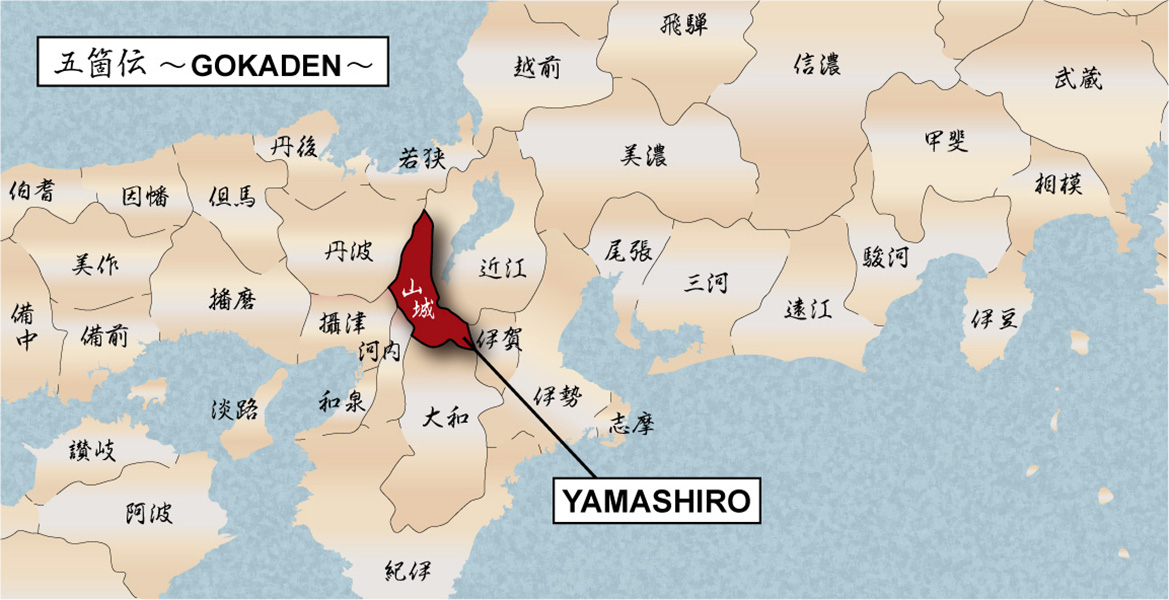
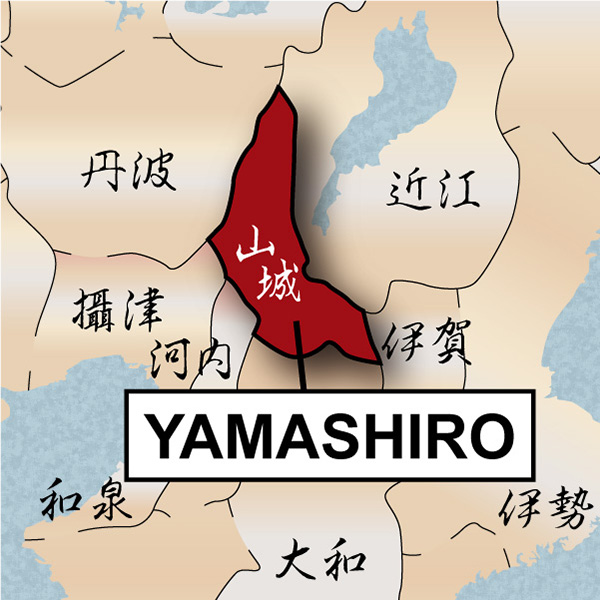
The first-gen Tanba no Kami Yoshimichi
The first-gen Tanba no Kami Yoshimichi belonged to Kyoto Mishina school and was one of the sons of the Mishina school’s founder. Mishina school was created by the first-gen Mutsu no Kami Omichi (陸奥守大道), also known as Kanemichi. It is said that initially, he was from Mino province, exclusively forging blades for Shingen Takeda, a famous feudal lord. Later on, he moved to Kyoto by bringing his four sons and founded his school in Kyoto. Five sons were Iga no Kami Kinmichi(伊賀守金道)、Izumi no Kami Rai Kinmichi(和泉守来金道), Tanba no Kami Yoshimichi(丹波守吉道) and Echu no kami Masatoshi(越中守正俊). His sons were known as Kyoto Gokaji(京都五鍛冶), prestigious swordsmiths forging in Kyoto in the early Edo period.
The first-gen Tanba no Kami Yoshimichi developed a unique Hamon pattern(tempering line) called Sudareba(簾刃). Sudare means traditional screens or blinds in Japanese. The Hamon pattern he invented resembles its appearance to Sudare. The Wakizashi blade has a beautiful Sudareba Hamon. This special characteristic was passed down to generations of Yoshimichi.
Mishina school was prosperous throughout the Edo period and spread to other parts of Japan, such as Osaka. The superb craftsmanship of the Mishina school was passed down for generations. The 3rd and 4th-gen Yoshimichi are a good examples, and you can see excellent artistry from these blades. Kyo Yoshimichi school lasted seven generations by the end of the Edo period.
What is Daisho?
Daisho is a pair of two Japanese swords Samurai carried. During the Edo period, having Daisho in public places was considered social status for Samurai. Furthermore, Samurai were required to wear them under the law back then. Daisho is written as 大=Big and 小=Small. Dai part means Katana, and Sho part means Wakizashi. We are confident you would like this pair of Daisho Koshirae.

Appraisal
This Katana/Wakizashi blade are appraised as a Tokubetsu Hozon Token(特別保存刀剣) . They were issued by NBTHK(Nihon Bijutsu Touken Hozon Kyokai:日本美術刀剣保存協会). These authentication papers were only given to authentic Japanese swords, especially well preserved and high quality with artistic value.
*Please keep in mind that there is small visible Kitae Kizu on the Katana blade. We would also like you to know that there are light black rust on the Wakizashi blade. If you like to know the detailed condition, please feel free to contact us.
【 Blade】
-Katana
Cutting Edge Length(Nagasa):75.4 cm ( 29.7 inches)
Curvature(Sori):1.30 cm ( 0.51 inches)


-Wakizashi
Cutting Edge Length(Nagasa):50.0 cm ( 19.7 inches)
Curvature(Sori):1.21 cm ( 0.47 inches)


Hamon:
The crystalline structure which forms along the cutting edge of a blade as a result of the hardening process
Jimon(Jihada):
visible steel surface pattern created by folding and hammering during forging process
-Katana






-Wakizashi
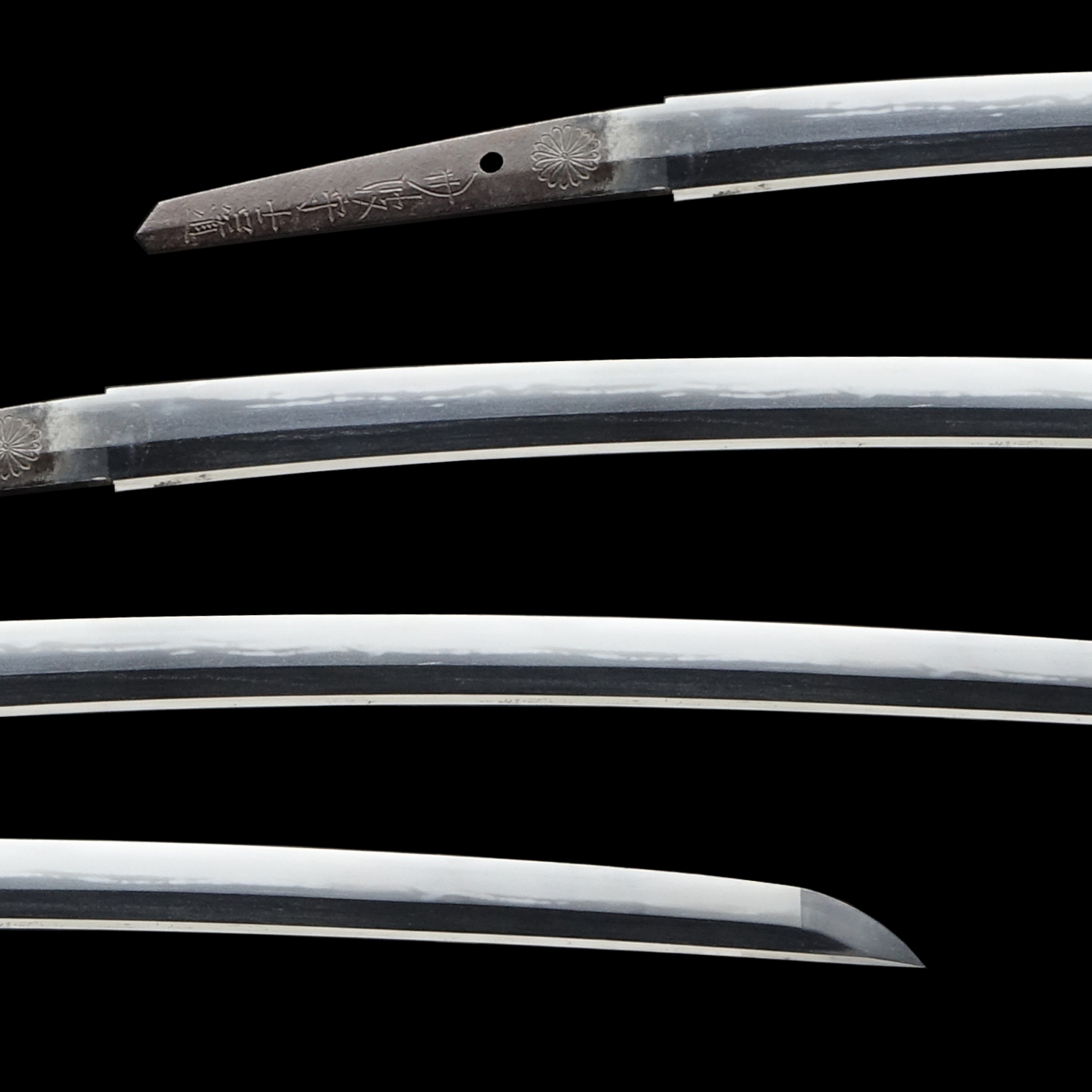





Nakago:Nakago is the tang of the Japanese sword.
Japanese swordsmiths left the black rust on the tang because it prevents red rust while the tang is in its handle. And the discoloration of the tang was created over time, and it is a great indicator for a Japanese sword specialist to estimate when the sword was forged.


Koshirae: Koshirae is the mounting of the Japanese sword. There are several parts that consist of Koshirae such as Saya(Sabbard), Tsuka( Handle), Tsuba(Handguard).
The theme of the Fuchi Kashira, Menuki, Kozuka and Kogai are Botan (牡丹, peony) flower. And, Karajishi (唐獅子) is also depicted on the Kozuka and Kougai. The combination of Botan and Karajishi is called Karajishi Botan (唐獅子牡丹).
Peony represents happiness, wealth, nobleness, and gorgeousness. This flower pattern has been treated as a good-omen motif; people regarded it as a rich harvest sign. As mentioned above, a peony is called the Botan in Japanese. When we write this flower’s name in Kanji characters, its second letter means mountain hermit medicine that would give us eternal youth. Based on the meaning of this letter, the peony pattern symbolizes eternal youth and longevity.
About the Karajishi, the Shishi (獅子) means a lion in Japanese, and the Karajishi is a lion brought from the Continent to Japan in the Toh period (唐, Tang dynasty, 618-907). The Karajishi typically has curly hair for its head, neck, body, and tail. In Buddhism, the Karajishi is regarded as a symbol of wisdom, and the Monju Bosatu (文殊菩薩, Manjushri Bodhisattva) rides lions. According to a theory, the Kara-Jishi originates from the Komainu (狛犬, stone guardian dogs that exorcize evil spirits). There is a Houwa (法話, Buddhist monks tell the story of Buddhism in an easy-to-understand manner) that treats the Karajishi and this flower. The lion is called the king of the beasts. However, even this invincible animal has only one fear: a bug in the lion’s body. This pest grows in the lion’s hair and eventually breaks the skin and bites the flesh. Nevertheless, it dies if it is exposed to the night dew of a peony. Therefore, the lion rests under peony flowers at night, looking for a haven. The design of these sword mountings might have been quoted from this story.

Fuchi-Kashira:A pair of matching sword fittings that cover the upper and bottom parts of its sword hilt.


Tsuka and Menuki:Tsuka is the handle of the Japanese sword and Menuki is its decoration.




Tsuba and Habaki:Tsuba is the handguard for the Japanese Sword and Habaki is the equipment to make the blade not touch its scabbard inside. It prevents the blade from getting rusty and chipped.
Cloud are the theme of this Tsuba. It brings rain and snow, and their movements significantly affect the weather of the day. Due to its supernatural power, a theory says that gods, spirits, and dragons dwell in the clouds. A religion worships the dragon as a water god in Japan. It might be one of the reasons why the combination of dragon and clouds motifs is often seen even in sword mountings.
The cloud pattern has been associated with magical power, and people thought it an omen of lucky things. In addition, some people wished to obtain a leisurely life in comfort by seeing clouds’ movements (that floats in the sky). Or, as clouds appear repeatedly, its design represents reincarnation. Samurais were always on the verge of life and death on the battlefield. They might have believed in the power of this pattern. And they had incorporated it into the design of their sword mountings, such as Tsuba.


Kozuka:Kozuka is a small knife stored in Kozuka Hitsu(groove of the sheath of the Japanese sword).


Kougai:Kougai is the equipment for Samurai to arrange or fix his hair style.


Saya: Saya is the scabbard for the Japanese sword.


Authentication Paper:NBTHK Tokubetsu Hozon Certificate for the Katana and Wakizashi (No.1019453, No.1019452)
NBTHK, also known as Nihon Bijutsu Touken Hozon Kyokai (the Society for the Preservation of the Japan Art Sword), is one of the oldest Japanese sword appraising organizations in modern-day Japan. They authenticated these two blades on December 14th in the 4th year of Reiwa (2022). They appraised both blades as a Tokubetsu Hozon Touken, the blade especially worth preserving for Japanese society. The purchaser will receive these original certificates as well. We can also translate what is written into English and make a PDF file for your record if you request.


Registration Number : Aichi 9500-9494
The Board of Education in Aichi prefecture issued a registration paper for this Katana and Wakizashi blades . It is called Jyu Token Rui Torokusho(銃刀剣類登録証). Bunkacho(The Agency for Cultural Affairs) acknowledges a Japanese sword with this paper as a work of art.
The sword needs to be traditionally hand-forged and made of Tamahagane carbon steel to be registered in the system. With this paper, its owner in Japan can legally own an authentic Japanese sword. Based on this registration number, we will apply for its export permit.
This paper will need to be returned to the board of education when the sword is being shipped abroad, but you can receive a copy of it. An English translation of this registration paper is available on request.



—————————————————————–
【About us】
Samurai Museum is located in Tokyo, Japan, exhibiting antique artifacts related to the Samurai history. Samurai Museum Shop is the place for those who are interested in Japanese culture and craftsmanship. We deal with antique Samurai swords/armor, traditional crafts made in Japan and so on.
【Japanese Sword& Export Process】
The Japanese swords we deal with are hand-forged edged swords made in Japan. It was made from the traditional carbon steel called TAMAHAGANE(玉鋼). Samurai Museum is familiar with the proper legal procedure for an antique/ authentic Japanese sword to be exported from Japan. We have sent more than 700 Japanese swords for the past few years (~2024) to amazing owners who appreciate its historical value.
Each Japanese sword is registered under the Agency for Cultural Affairs and the Board of Education in Japan. They issue a registration paper for each Japanese sword for its owner in Japan to legally possess it. The Japanese sword with its registration paper means it was traditionally hand-forged in Japan.
To legally export the sword from Japan to other countries, we will have to apply for its permit to the Agency for Cultural Affairs(Bunkacho) and return the original registration paper to the Board of Education. It normally takes around 2-4 weeks to receive this permit after submitting required documents. And we would like you to expect at least 1-1.5 months for your order to arrive at your given address after you ordered. For more detailed info, please click here.
It is allowed for residents in Japan to own authentic Japanese swords without a special license as long as they come with registration papers. Please feel free to contact us if you are a resident of Japan, whether temporarily or permanently. We will also assist you when you leave Japan and need to obtain the export permit.
【Payment Method】
We accept payment through Stripe (Credit card), PayPal, Apple Pay or ChromePay, all of which are secure payment methods. Also, you don’t need to make an account on Stripe for the checkout. If you prefer other payment method, please contact us. After confirming your payment, we will apply for an export permit. You may either pay in JPY, USD, AUD, CAD,EUR CHF or GBP. The price is set in Japanese Yen. Prices in other currencies are automatically calculated based on the latest exchange rate.

* If the amount is above 1 million JPY, Stripe or wire transfer will be the only options for payment.
【Shipping】
We have shipped authentic Japanese swords to the USA, Canada, Mexico, Germany , Belgium, France, Finland, Hong Kong, Australia. If you don’t live in these countries and like to order, please contact us first before making a purchase. We offer Free International Shipping as long as we can send antique Japanese swords by EMS.
We normally ship by EMS(Express Mail Service) provided by Japan Post. We will send you a tracking number for your order as soon as we hand it to the post office. We will put 100 % insurance on the shipping document without any extra charge. Based on the total amount, there might be a duty tax or other fee for you to pay, depending on the countries. We use package cushioning to protect the item and put it in a PVC pipe, which is one of the most secure packages because of its durability.
It will normally takes 5-14 days for the item to arrive at your given address after we dispatch it. Time of delivery is estimated as accurately as possible by the carrier but does not take into account any delays beyond our control such as by inclement weather, post office holiday seasons.
* If you live in Australia and like to purchase an authentic Japanese sword, please click here to know the detail.
* If you live in the UK and like to purchase an authentic Japanese sword, please contact us first and click here to know the detail.

【Review】
Here is one of the reviews we received from a customer who purchased an authentic Japanese sword from us. For more reviews, please click here.
“My experience overall with the whole process was wonderful. I had many questions about the history and process to purchase these treasures. All my questions were answered very timely and complete. The staff is very knowledgeable and very well versed if any questions do arise.”
【How to make sure the condition】
Please keep in mind that what you are going to purchase is an antique item. We uploaded high resolution photos for you to check its condition thoroughly. If you like to see more photos with different angles, please feel free to contact us. We will be happy to send them to you so that you can make informed decision. It is essential for us to know that you are happy with your choice of a sword. and we are prepared to use the best of our ability to serve you.
【How To Contact Us】
Please contact us through email, Facebook Messenger or Live Chat if you have any questions. You can find each icon on the right side of the website. Please click one of them to reach us. We will reply to you within 1-2 business days.
【The Art of Nihonto (Japanese Sword)】
Samurai’s history is a profound, eloquent legacy of ancient Japanese warriors in which millions of people worldwide are being fascinated. If you like to find out the art of Nihonto, please click here.
【A Guide to Japanese Sword Maintenance】
After acquiring an genuine Japanese sword, it is also important to know how to take good care of it. Here is the special video for you. Mr. Paul Martin, Japanese sword expert, shows you how to give proper maintenance to your sword. By mastering how to clean the Japanese sword, its aesthetic beauty will last forever.
When you purchase a Japanese sword from us, you can get a Free Japanese sword maintenance kit. It comes with four tools(Choji Oil, Uchiko Whetstone Powder, Peg remover, Oil Applicator). By watching the video instruction above , you can enjoy learning how to maintain your Japanese sword while appreciating it. If you have any difficulty assembling the sword or cleaning the blade, you can feel free to contact us.


MORE ANTIQUE JAPANESE SWORD FOR SALE
SWORDS WITHOUT CERTIFICATES FOR SALE
LEARN JAPANESE SWORD TERMINOLOGY
Thank you for reading all the information on the page. If you have any difficulty choosing the right Japanese sword for you, we will be more than happy to help you find the one that speaks to you the most. Please feel free to contact us.







